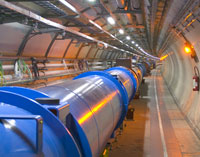First attempt at 7 TeV collisions in CERNís LHC scheduled for 30 March

- © CERN/Maximilien Brice
- Magnets in the 27-km long LHC tunnel
CERN, the European Organization for Nuclear Research, one of the worldís leading particle physics laboratories has scheduled its first attempt for collisions at 7 TeV for 30 March in the worldís largest and most powerful particle accelerator, the Large Hadron Collider (LHC).
Since the re-start in November 2009 of the worldís largest and most powerful particle accelerator, the Large Hadron Collider (LHC) of CERN, the machine is set to attempt proton beam collisions at 7 tera-electron-volts (TeV) (3.5 TeV per beam) on 30 March. As of 23 March 2010, proton beams are routinely circulating at 3.5 TeV in the LHC.
This milestone will mark the LHC First Physics Run. The machine will continuously run at 7 TeV for 18-24 months, which will deliver enough data to make way to new discoveries and make significant advances in physics. With important quantities of data recorded, there will be a real chance of discovering supersymmetric particles, possibly explaining the nature of dark matter, the Higgs particles, if it has a mass of around 160 giga-electron-volts (GeV), and new massive particles of masses up to 2 TeV.
The current LHC run started on 20 November 2009, with the first proton beam circulating at 0.45 TeV. Soon after, on 23 November, twin circulating beams were established. On 30 November, a world record beam energy of 1.18 TeV was achieved, and by 16 December, collisions were recorded at 2.36 TeV that resulted in major amounts of data recorded. After a short technical stop, beams were again circulating on 28 February 2010, and the first acceleration to 3.5 TeV was on 19 March. This run will be followed by a single shutdown during which preparations will be done for 14 TeV collisions.
CERN and UNESCO have had a long tradition of mutual collaboration and special links dating back to the creation of CERN in 1952. At an intergovernmental meeting of UNESCO in Paris in December 1951, the first resolution concerning the establishment of a European Council for Nuclear Research was adopted.
A webcast will be available on the day of the first attempt to collide protons at 7TeV. More details will be available at: http://press.web.cern.ch/press/lhc-first-physics/
Related link:
:: Our understanding of the Universe is about to change... (More)
- Source:UNESCO SC
- 26-03-2010

